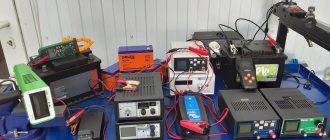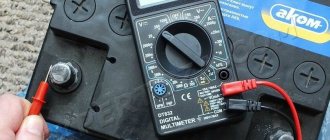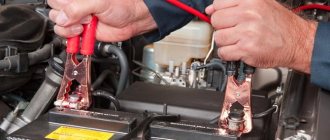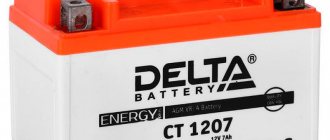A car battery not charging is a common problem faced by many drivers. Novice motorists, as a rule, get rid of such a power source and allocate funds for a new device. Additional costs can be prevented if the true cause of the discharge is determined.
How do you know if the battery is not charging?
Charging and checking battery density
How can a motorist know whether the battery charge level is low or the battery does not hold a charge? If the battery does not charge, this will affect the functionality of all electrical equipment. During normal operation of the car, the battery is always slightly charged from the generator. Therefore, if the battery is completely discharged, you can try to jump start the car (this does not apply to vehicles with automatic transmissions).
But the car battery may not be charged even despite the generator. How can the driver be sure of this? To carry out diagnostics, a tester is used that allows you to measure voltage. If the battery is operating in normal mode, during diagnostics the voltage level will be 14 volts, and if the battery is not charging, this parameter will be only 12 volts. The diagnostic procedure is performed with the engine running, otherwise the results will be incorrect.
If the engine cannot be started, a tester is used to measure the parameter at the battery terminals. With a zero charge of the device, the resulting indicator will be 11.8 volts, and if the battery is fully charged, this parameter will be equal to 12.8 volts. In addition, if you use a battery charger, the voltage reading will always change at the device terminals during the process.
Symptoms that the battery is not charging
How can a car enthusiast understand that the battery is not charging? If it happens that the battery does not charge, then this will, one way or another, affect the operation of the electrical equipment in the car. In normal operation, the battery charge is replenished using a generator device. However, even the operation of the generator does not always allow the battery to function again.
What symptoms can you use to determine the lack of charge:
- The battery light on the dashboard is on. When the car's battery charge level is too low and the battery is heating up, an indicator light will appear on the dashboard. But the appearance of a light bulb can also be caused by incorrect operation of the generator with a loose drive belt.
- If the battery does not hold a charge, then the voltage at the battery terminals will be about 12 volts. With proper charging, this parameter will be 14 volts. To check this parameter, you will need a multimeter, and the diagnosis should be carried out with the power unit running.
- The inability to start a car engine is one of the main symptoms. If the battery drains completely, the device will not be able to power the electrical equipment installed in the car. Also, the device will not be able to perform the primary function assigned to it, namely, turning the starter and crankshaft and starting the engine (video shot by Andrey Amochkin).
The main reasons why the battery does not charge
Oxidized battery terminals are one of the most common problems.
For what reasons does the battery not charge? Why may the device become warm and not charge?
- Terminal oxidation. When charging, the battery often does not charge for this reason. Perform a visual diagnosis of the battery - if a white coating is visible on the terminals, charging will be impossible, since such oxidation will cause high resistance. You can get rid of such plaque, but it must be done as carefully as possible. Plaque is removed using fine-grain sandpaper. It is only necessary to remove the plaque; the lead must retain its layer, otherwise the terminals may fall off the battery when driving on a rough road.
- If there are no results when charging, this may be due to a broken alternator strap. In some cases, this problem occurs as a result of the belt weakening or slipping on the shaft. In the event that the belt breaks, it will be visible. Such a malfunction can only be eliminated by replacing the belt. As for slippage, there can be many reasons. For example, sometimes this occurs as a result of wear or stretching. Quite often, the belt slips as a result of moisture getting on it or the pulley itself, as a result of which the adhesion force between these elements is reduced. Accordingly, the battery charge will be insufficient. If the strap is simply worn out, it will be enough to tighten it; if there are traces of moisture on the pulley, it must be dried before further use of the car.
- If the battery is heating up, but the battery is not being recharged enough, the cause may be oxidation of the wires on the generator. This kind of malfunction can be solved by stripping the terminals and wires, for which fine-grained sandpaper is also used. However, the wiring does not always oxidize; sometimes the wires can burn out or break due to voltage surges. It's not that difficult to identify. Typically, if wires burn out, the driver will be able to smell the smell of burnt insulation. Before replacing a burnt-out wiring with a new one, it is necessary to identify the cause, otherwise even new wiring will burn out over time. Moreover, the consequences in the latter case can be even more serious.
- There may be poor charging, or rather undercharging of the battery from the generator. If you have short runs between engine starts, the generator simply does not have time to recharge.
The main reasons why the battery may not charge
To understand in detail all the possible malfunctions due to which the car battery does not charge, first of all, clearly define the situation:
In general, when the battery refuses to charge, the following options are allowed:
- plate sulfation;
- destruction of plates;
- terminal oxidation;
- decrease in electrolyte density;
- short circuit
But you shouldn’t worry so much right away, everything is not always so bad, especially if such a problem arose while driving (indicated by a red battery light). It is necessary to consider special cases in which the car battery does not take charge only from the generator or from the charger as well.
The charging system of a car battery contains a number of external devices, on which the performance of the battery itself and the charging process can also greatly depend. To check all external devices, you will need a multimeter (tester); it will allow you to measure the voltage at the battery terminals under different engine operating modes. You will also have to check the generator. But this is only true when the battery does not want to be charged from the generator. If the battery does not take a charge from the charger, then it is advisable to also have a hydrometer to check the density of the electrolyte.
The battery does not charge from the charger: external factors causing the malfunction
When charging the battery, the charger should heat up, since current will flow through it. If the charging battery does not hold a charge, it is necessary to promptly identify the cause. The diagnostic procedure in this case includes the use of a tester to measure the voltage parameter at the terminals of the device. The process itself is carried out with the engine turned off.
For the device terminals, the normal voltage should be 12.5-12.7 volts. If, after connecting the charger to the battery and starting the engine, this parameter does not increase to 13.5-14 volts, it is necessary to increase the dynamics of the power unit and watch how the indicator changes. If, as the engine idle speed increases, you notice a decrease in the parameter, this may be due to problems in the operation of the generator device relay diodes. It is also advisable to visually inspect the condition of the brushes - these elements can wear out over time.
The relay diodes can be changed if necessary, and if necessary, the relay can also be replaced. If you are only changing diodes, then keep in mind that during normal operation they will pass current in one direction. If the current flows in both directions, this indicates that one of the diodes may be broken. Moreover, if you decide to change only them, you will have to use a soldering iron, and for this you need to know how to use it (the author of the video is SAOS + about everything in the world).
Once the new diodes are in place, you need to check how they work. If they heat up when the motor starts, this indicates that they are receiving excessively high current, which is bad. Moreover, constant overheating significantly reduces the service life of diodes. Therefore, the best option would be to simply replace the relay.
Which batteries are not afraid of deep discharge?
Gel batteries, which use a gel made from a mixture of sulfuric acid and a stabilizer instead of an electrolyte, are not afraid of deep discharge.
Such batteries are used in:
- City and railway transport.
- Alarm systems.
- Computers.
- Water supply systems.
The main advantages of gel batteries include:
- Does not require regular maintenance.
- Work in any geometric position.
- They work with a damaged body.
- They serve for a long time.
- High starting current capacity – stable 12.7 V.
- They are not afraid of a strong discharge.
Battery troubleshooting and troubleshooting
Repair of the charger is required if the charger is inoperative. One of the main reasons why a battery shows no charge is sulfation.
In this case, you can restore life to the battery; you must perform the following steps:
- First, the device is washed with distillate to remove dust and dirt.
- Next, the battery is dried and fully charged.
- Then the density of the electrolyte must be increased to 1.28 g/cm3; to do this, add a liquid whose density is 1.4 g/cm3 to the system.
- Charge the battery until the charge indicator is 1.3-1.4 volts; under no circumstances should the electrolyte be allowed to heat up or boil.
- If the voltage level does not change for several hours, the procedure can be completed. It is again necessary to add distillate to the device. Then, using a regular lamp, reduce the voltage on each section to 1. volt. If it ultimately turns out that the battery cannot be restored, there is no need to “squeeze” the last out of it - it is more advisable to get a new battery.
Sorry, there are no surveys available at this time.
Why won't the battery charge from the charger? What is the reason, where is the problem?
Sometimes there come moments when drivers begin to wonder why the battery is not charging from the charger.
This can happen both with a new battery and with an “old” device. In some cases, the culprits of this situation are the owners of the machines; in other situations, the sources of such malfunctions may be the manufacturers of these devices. The operation of this device must be approached seriously and responsibly, otherwise it may fail before the established time limit. Why the battery does not charge from the charger will be interesting to know for those car owners who have not had such problems. Knowing the possible causes of such a situation will allow you to avoid them in the future. There are several reasons for the appearance of such problems, so let’s try to talk about them more specifically.
A common cause is terminal oxidation.
When all the electronics of the car, as well as its generator and starter, are working normally, but the battery still does not hold a charge and quickly loses it, the most likely reason for this is oxidation of the terminals. When the car terminals oxidize, a dense white layer forms on them, which prevents the current from fully powering the battery, and the car battery cannot fully take electrical energy to accumulate inside itself.
To prevent such situations, you need to regularly check the condition of the terminals and be sure to clean them , as well as treat them with a special compound that prevents oxidation. The economical option in this case is solid oil, but over time it also greatly degrades electrical conductivity. Therefore, it is better to use lubricants purchased in specialized stores.
If the acid has “eaten through” the terminals thoroughly, they should be replaced immediately. It follows from this that poor or careless care of the car and all its components should not be allowed.
What is a battery and why is it needed?
This device is a device that acts as a “storage” of energy, and it is stored in chemical form; it can subsequently be used to power machine systems. This can happen when two different metals in an acid solution begin to produce electrical voltage.
A battery is needed in a car to start the engine and power various electronic equipment, which is becoming more and more common on modern cars. This device is recharged from a generator while the car is moving, but periodically, especially in cold weather, it needs to be charged with a stationary charger.
During the operation of the vehicle, the battery, like other units, requires systematic monitoring and maintenance. You should monitor the electrolyte level in the battery banks and also check its density. For the central regions of the Russian Federation and most CIS countries, its value should be equal to 1.27 g/cm3
. For areas with cold climates, it should be slightly higher, otherwise there will be difficulties starting the engine in cold weather.
A reason that will surprise many: short trips
Of course, experienced drivers, as well as auto electricians, are well aware that any short trip in the cold winter causes the battery to lose its energy much faster. After all, starting the engine consumes most of the battery power. And if a person gets to work in ten to fifteen minutes, the battery simply does not have time to “swing” during the journey in order to replenish the energy that it lost when starting the engine. This may be another popular reason why the battery does not hold a charge and can discharge so quickly in the winter.
What should you do in such a situation when the battery discharges quickly in winter, during short trips? The answer is simple: to allow the battery to replenish lost capacity, make at least two or at least one trip per week lasting half an hour or more . This will help avoid its premature discharge. In addition, it is recommended to purchase batteries with higher starting currents in advance - specifically with future calculations for “cold start” times.
This is interesting: Why doesn't the power bank charge the phone battery?
A few words about charging batteries
The generator set cannot always replenish the energy consumed by the battery, especially during the winter period of vehicle operation. Therefore, periodic recharging with an external charger is required. To implement this, certain rules have been developed, following which will preserve the battery’s functionality for a long time.
Before starting this procedure, you need to fully service the battery, clean its surface and terminals, and only then connect the charger. The battery operating instructions recommend setting the charging current, the value of which should be no more than 10% of the battery capacity. You can recharge with lower currents, but the charging time will increase. Currents greater than the recommended values in the instructions can lead to premature failure.
Charging the battery from the generator
While the vehicle is moving, the electricity generation installation generates charging voltage, which is the main resource for recharging the storage unit. The process of charging the battery from the engine is carried out in a gentle mode, completely eliminating the possibility of boiling the electrolyte in the banks.
What kind of charging should go from the generator to the battery?
How much should the battery be charged from the generator to ensure its full operation? It is generally accepted that to fully replenish the energy costs of a battery, a generating device with a charging current volume of at least 10% of the capacity of the storage device will be sufficient. In other words, for a 70 ampere/hour battery, the generation system must provide at least 7 amperes of charging current, which will be normal charging of the battery from the generator. The power of the storage source must comply with the recommendations of the vehicle manufacturer.
If a more powerful storage unit is used, the current value generated during operation of the car engine may not be enough to fully restore energy consumption. This can further lead to battery discharge and problems starting the engine. In addition, you should remember about the load from all electrical appliances that the machine is equipped with - the generating source must also cope with it.
How can an ordinary car enthusiast check whether the battery is charging from the generator?
How to independently check whether the generator is charging the battery?
Motor vehicles of the 21st century are equipped with on-board electronic systems that control the operation of all mechanisms, and also allow checking the battery charging from the generator. If the battery loses charge, its icon on the instrument panel will light up red. In addition, with the help of modern electronic devices you can monitor the voltage value in the network.
But what about those who have an old-style car, without bells and whistles? There are so-called “driver’s” methods that allow you to check whether the generator is charging the battery:
- Removing the terminal from the battery - if the generator malfunctions, the engine will immediately stall (only suitable for systems with mechanical ignition).
- Short circuit of the positive terminal to ground for a short time - check for a spark.
The above methods cannot be used when diagnosing modern cars - the control unit, fuses or diode bridge will instantly fail.
How to check the charging of the generator with a multimeter?
The operation of the generator set should be monitored and diagnostics of current, voltage and resistance values should be carried out at least twice during the year.
How to check if the battery is charging? Diagnostics of potential difference can be carried out using two methods:
- Directly on the generator winding.
- Through the battery pack, with which the energy generation source is inextricably connected directly with a large cross-section wire.
Let's connect the wires of the device in any order to the battery terminals and determine the mains voltage, the value of which should not be lower than 12 V. When the engine is idling with the load completely disconnected, the permissible voltage is determined by the range from 13.5 to 14 V. In this case, deviations of no more than 0.2 V down or up.
Why is the battery not charging?
To charge the battery, various types of chargers are used. They can be automatic, adjustable or unregulated. When used correctly, the charging process can last from 12 to 15 hours. However, in some cases it may be absent for various reasons; let’s consider these reasons.
The culprit could be either the charger or the battery. First of all, you should make sure that the memory is working. Such factory-made devices have indicators for connecting to the electrical network in the form of a light bulb or LED, as well as fuses at the input and output of the device. If the power indicator is on but there is no charge, check the output fuses.
Sometimes the problem is a faulty plug on the power cord or the wires connecting to the battery. If after all the checks it turns out that the charger is in order, you should inspect the battery. There are a number of malfunctions due to which the battery will not be charged:
- Increasing battery self-discharge does not allow you to receive a full charge. This may occur due to contamination of the battery surface. Using “bad” distilled water also leads to self-discharge of the battery. You can try to completely discharge it and then charge it again, before doing this you should completely replace the electrolyte;
- The destruction of the battery plates for the most part leads to the appearance of a short circuit inside the device, this will not allow obtaining the required charge;
- Severe oxidation of the battery terminals, it can be eliminated by cleaning them from oxides (see the article “How to lubricate battery terminals”);
- Overcharging with high voltage leads to overheating of the battery, and as a result, the plates become warped, so charging will be impossible.
It may also happen that no external damage is noticed and there is no charge. This can happen when the battery has reached the end of its service life. As you can see, there are not many reasons. We tried to tell you why the battery does not charge from the charger. Carefully follow all the rules for operating and maintaining this device, then such problems will bypass you.
Why is my car battery not charging?
First you need to clarify two things.
The battery does not charge due to its failure or because it does not receive charging current from the generator.
This will be indicated by a burning red light with a battery symbol. To make sure, you need to check the voltage at the battery terminals with the engine running. It should be within 13.5-14.5 V.
You can also check the battery by charging it from the charger. If there is no charging, then it is a defect in the battery itself.
The malfunction may be due to the following reasons:
- service life has expired. Usually it is 5-7 years;
- terminal oxidation;
- low electrolyte density. Measured with a hydrometer. The norm is 1.25-1.29 g/cu.m. cm. Decreases with evaporation of the electrolyte;
- plate sulfation. Occurs during deep discharge, strong cooling, long-term storage of an uncharged battery, increased electrolyte density;
- short circuit in one of the cans;
- destruction of plates;
- reversal of poles;
- impurities in the electrolyte.
If the battery is recharged well from the charger, then the reasons for its discharge may be:
- generator belt break;
- belt stretch;
- oxidation of wires on the generator;
- failure of diodes;
- wear of generator brushes;
- failure of the relay regulator.
Poor battery charging can occur without a malfunction. This happens if there are short runs between frequent engine starts. He simply does not have time to recharge.
Causes of car battery charging problems
You can determine why the battery is not charging if you use an effective method.
This is interesting: What happens if you pour oil into the engine?
Reduced density of electrolytic composition
A hydrometer is used to check density. Testing is carried out for each jar. The new battery has a density of 1.26–1.27 g/cm3. As the battery charges, the density of the electrolytic composition gradually increases. If the density level does not change, then the car battery does not charge. Problems with the electrolytic composition are also indicated by the presence of suspension and turbidity.
The recovery procedure is performed at the following intervals:
- The cloudy composition is carefully drained. For these purposes, rubber gloves and protective clothing are used. After all, the electrolyte contains components that can cause harm.
- Purified distilled water is used to rinse jars.
- When pouring a new electrolytic composition, the degree of density is monitored. If necessary, the car battery is charged.
When washing, monitor the condition of the lead plates and contacts.
Short Circuit in Lead Plates
The battery will not charge from the charger if the lead plates are short-circuited. This happens due to partial or complete shedding of lead, its contact with the conductive terminals and ends of the electrodes.
Another reason for short circuit is failure or wear of separators. This brings the negative and positive terminals into contact. Various deformations lead to such effects.
In some cases, cans can be restored. If such actions cannot be carried out, then the battery is replaced.
Sulfation of lead plates
Often the battery does not take a charge due to the formation of plaque (sulfation) on the conductive terminals. This effect occurs because the power supply is not fully charged for a long time. At the initial stage, the battery is restored. To do this, cyclic charging is performed.
The power source does not charge completely even if the integrity of the case is damaged. After all, this provokes the leakage of the electrolytic composition and evaporation of the liquid. To seal microcracks, soldering and adhesive are used. Restoration is carried out after draining the electrolytic composition, washing the cans and drying the body.
Cleaning of conductive terminals is carried out according to a certain scheme:
- The power supply housing and banks are washed. For this purpose, distilled water is used.
- The thoroughly dried battery is filled with an electrolytic composition with the required density. Using the charger, the source is recharged. During the process, the density is checked. If necessary, administer liquid or distilled water
- The charging unit does not turn off until it charges the battery. Every section is checked.
- If the power source or battery on the laptop does not charge, then the charger is turned off. Check the density and fill in the electrolytic composition.
The sulfation process is often confused with the destruction of lead plates. This is not difficult to identify. To do this, check the electrolytic composition. If there are particles or suspension in it, then it is better to replace it.
Problems with the generator
The battery does not charge from the generator due to a number of reasons. In order to quickly identify these problems, you need to know their characteristics.
Belt problems
If the generator does not charge, then the problem may lie in the integrity of the belt. Even an inexperienced car owner will detect serious damage. It is more difficult to determine its weakening. Indeed, in this case, the generators either provide charging or not.
To identify problems with the belt, look at the indicators and lights. They glow almost constantly. To eliminate this, tighten the belts or completely replace them.
Faulty diodes, regulators, brushes
The generator does not charge the battery if faulty diodes are included. Such elements are identified using multimeters or testers. It is possible to replace one diode or the entire bridge. Incorrectly functioning elements cause the battery to be poorly charged or recharged.
When the power supply is overcharged, the diodes, which are operating normally, heat up. Voltage surges result from the use of an ineffective regulator. It is replaced immediately.
Poor charge occurs because the brushes that make up the generator wear out. If the replacement is not made, the generator does not charge the power source.
Polarity reversal
If the battery of a laptop or vehicle is completely discharged, perform a polarity reversal. If done correctly, the power supply will charge. Polarity reversal can be performed if changes in the poles can be observed. Otherwise, the charging unit should not be connected.
This is interesting: How to adjust the side door on a Gazelle?
When determining pole reversals, you should focus on the capacity of the cans that are included in lead-acid batteries, but not other sources. For recharging, use only those chargers that are equipped with protective elements.
Polarity reversal is not performed if:
- The electrolytic composition has become cloudy and the charged car battery is quickly discharged.
- The lead plates were destroyed.
- KZ banks, which is included in the composition.
- Low composition density.
Overload
Why does the battery receive a charge, but the voltage does not increase? The main reason is generator overload. This is caused by the connection of standard and non-standard electrical equipment, various gadgets and installations. In this case, the generator operates at the limit.
Such difficulties arise for new car enthusiasts. After all, they use a variety of units and devices, acoustic systems, and lighting equipment for tuning. Sometimes car batteries are upgraded by increasing the power level of the power sources. Therefore, the output voltage does not “cover” all costs.
The generator does not produce rated voltage
When determining why the battery is not charging, specialists constantly disassemble the generator. These steps allow you to identify the following faults:
- The damaged pulley is replaced. To identify such a defect, this element is periodically inspected.
- Abrasion of current collecting brushes. During active use of vehicles and car batteries, current collection brushes are periodically replaced. When selecting elements, they are guided by the manufacturers’ recommendations.
- Wear of slip rings. Copper components lose integrity and properties. This results in a reduction in the rated voltage. As a result, the generator does not produce a charge.
- Violation of the integrity of the diode bridge. Damaged diodes are soldered or pressed in. It is very important to carry out all processes correctly. Soldering irons and other tools are used for these purposes.
The car battery does not charge for various reasons. If the problems are related to current leakage, then elimination of them must be started immediately. After all, a malfunction of the electrical system leads to short circuits, fires, etc. You need to check not only the car battery, but also the generator. After all, it is not difficult to disable it. For example, such consequences result from the installation of non-standard equipment, untested units and installations.
Other reasons
Why won't the generator charge? This occurs due to rapid wear of the rotor, which does not perform rotational movements and gets stuck in the stator. The rotor stop frequency varies. The only way to cope with this problem is to dismantle the old installation and install a new unit that works normally.
A breakdown in the circuit is an equally common problem due to which the car battery does not take charge from the electric generator. It is problematic to independently identify why the generator stopped functioning. Car mechanics and workshop workers are involved in this event.
The smartphone is not charging at all
Check the USB connector
One of the most common reasons for poor contact when charging a smartphone (it is expressed in the constant switching on and off of the charging mode) is ordinary contamination of the USB connector. Most often, older Micro-USB connectors, which have recesses for snapping the spring-loaded fasteners of the connector, suffer from this.
Recesses where dirt can accumulate are marked in red.
The solution is simple - carefully clean the inside of the connector with a thin, pointed tool. An ordinary toothpick is ideal for such purposes: it is difficult to damage the connector with soft wood, and besides, it does not conduct electricity, so you do not have to worry about a short circuit. The image below shows the area to be cleaned in blue, but pay special attention to the notorious recesses - they are marked in red in the previous image.
The area to be cleaned is highlighted in blue.
Check the cable
Of course, it is best to use the supplied cable to charge electronics, but only when it is not physically damaged. Even if at first glance the wire is intact, make sure that you have not crushed it (for example, by slamming the drawer of the nightstand). And you certainly shouldn’t use a cable with visible damage: gradual grinding of the insulation of individual conductors can lead to a short circuit and costly repairs to the gadget itself.
If you are using a non-native cable, difficulties may be caused by microscopic differences in the sizes of the connectors themselves - this is again relevant primarily for Micro-USB. Two identical-looking connectors sometimes differ in thickness by a few fractions of a millimeter. In this case, one cable will charge the smartphone without problems, while the other, with a slightly smaller connector, will constantly lose contact. Well, if we are talking about the length of the connector, it is obvious that a shorter one may simply not reach a deeply located connector, for example, in a secure smartphone.
The charging speed is also affected by the length of the cable. If it is a meter or more, the maximum power can vary by more than 50%, according to a study conducted by a user on the XDA Developers website. Electrical resistance is to blame. Unfortunately, there is no escape from Ohm's law.
Dependence of charging power on cable length
Finally, you should not use cheap, thin, or any other untrustworthy cables for fast charging. Fast charges produce a high current, which can cause the insulation of a “doubtful” cable to melt, which can lead to a short circuit and, in the worst case, a fire.
Charging too slow or incomplete
Check the power supply
If your gadget's battery indicator quickly reaches 100% at home, but is much slower at work, then the problem is most likely with the charger. Read the specifications on the charging case. For a typical modern smartphone, a charger with an output current of 2 A (two amperes) is suitable. Old chargers with a rating of 1 A charge, but much more slowly, and 500 mA is only suitable for fitness bracelets.
If two-amp charging takes too long to fill the battery, look at the rating of the standard charger: what current (A) and voltage (V) it produces. Buy a charger with similar characteristics.
A tablet or “transformer” may simply refuse to charge when using a low-power power supply. Some tablets in this case show a crossed out battery icon in the notification panel. The solution is simple - use a more powerful power supply, or even better, a proprietary charger from the manufacturer.
Are you the happy owner of a gadget that supports fast charging, but after purchasing a power supply with this feature, you didn’t notice an increase in charging speed? Check whether the fast charging standards of the smartphone and the charger itself match. There are almost a dozen of these same standards, and most of them are incompatible with each other. We looked at “fast” technologies in detail in one of the previous articles. A power supply of an inappropriate standard can be used without fear, but you will not get an increase in charging speed.
If you have a zoo of different smartphones at home, it is convenient to use universal chargers. The photo shows a power supply with simultaneous support for Quick Charge from Qualcomm and Pump Express from MediaTek
Do not use your smartphone while charging
Charging efficiency drops noticeably if you use a gadget during the charging process. This primarily applies to games and other applications that actively use smartphone resources. If the device is connected to a low-power power supply, it may even begin to discharge. In addition, simultaneous charging and use of the gadget leads to excessive heating, which also does not benefit the battery. Finally, manipulating a smartphone with a cable connected to it leads to premature wear of the connector.
Software problems
If your device has unofficial firmware installed, then slow or incomplete charging may be associated with it. Custom builds often contain bugs, including hidden ones, so to check it’s worth returning to the stock software, at least temporarily.
Very often, if the battery is not fully charged or discharges non-linearly, it is recommended to calibrate the battery. This does make sense, but only for tablets and other “large” gadgets with multi-cell batteries. If you have just such a device, we recommend that you occasionally carry out a full discharge-charge cycle to equalize the charge levels in all battery cells.
Solving problems with wireless charging
You can encounter various problems when using wireless charging. If your smartphone charges slowly on the cradle or does not charge at all, the first step is to get rid of the case. Wireless chargers have a limited range, so some models may not “pierce” a case of a certain thickness, especially if it has metal inserts. And in general, you need to make sure that there is nothing superfluous between the gadget cover and the charging platform.
Sometimes difficulties with wireless charging are software-based - the station simply does not recognize the smartphone. The charging LED blinks, but the device does not charge. The solution is simple: remove the gadget from the station, wait about five seconds and put it there again. In particular, we had this problem with charging the Samsung NG930.
If you just purchased a wireless charger, but it doesn’t work with your device, make sure that the gadgets use the same standard. If you still make a mistake, unfortunately, you will have to return the unsupported charger to the store and buy the “correct” one.
Many modern flagships, in addition to “regular” wireless charging according to the Qi or PMA standard, are capable of supporting “fast” charging. If you want to use fast wireless charging, you will need a compatible power supply - the requirements for this are usually described in the instructions for the charger. Of course, a wireless device can be connected even to a computer’s USB port, but the charging speed in this case will be low. USB 2.0 ports on desktops and laptops output only 0.5 A, while USB 3.0 outputs 0.9 A.
Even such a simple procedure as charging gadgets is not without nuances, and not entirely obvious ones. In the article we looked at the most common causes of problems and methods for eliminating them. But we might have missed something. Share in the comments, have you ever solved similar problems? How did you manage to overcome them?
The battery does not charge through the charger, what should I do?
If the battery has not been used for a long time. For example, bikers remove them from their motorcycle for half a year. For reanimated batteries, the amperage is increased when charging, and charging takes longer.
Why don't European women do makeup, manicures, styling and hairstyles?
Why is the sea salty?
What's better: sleeping an extra 20 minutes or putting on makeup?
How to balance colored arrows in makeup?
What kind of makeup can be both casual and party-ready?
How to use decorative cosmetics and at the same time maintain healthy skin?
What makeup do you think is the most tasteless? Why?
How to become a successful makeup artist if the competition is very high?
What's better: sleeping an extra 20 minutes or putting on makeup?
What's better: sleeping an extra 20 minutes or putting on makeup?
What makeup do you think is the most tasteless? Why?
Cost of personal bankruptcy?
How to wish happy birthday?
Why is the price of Bitcoin constantly rising?
How is an accountant different from an economist?
How to fall asleep?
How to increase basic activity while staying at home in quarantine?
What is the significance of breathing?
Why is it important and how to take care of yourself during quarantine?
Why is it important and how to take care of yourself during quarantine?
How to eat properly during PMS?
How to change the language in Photoshop?
How to translate Photoshop into Russian?
where in English Photoshop change the language to Russian
What to do if the laptop does not charge, but the charger is connected?
I encountered a similar problem myself. In my case, replacing the power connector helped. Its cost is low, the main thing is to find it specifically for your model. And, if you don’t know how to use a soldering iron, or even better, a soldering iron, then it’s better to contact someone who knows how or to a service center. Desoldering an old connector is quite risky and the process itself is not quick.
How to properly charge a smartphone so as not to damage the battery?
Previously, the main rule for charging a battery was to completely discharge it and fully charge it, without interruptions. Today, the type of batteries has changed from lithium to lithium-ion. Modern batteries are recommended to be charged already at 15% of the battery charge and, if necessary, to be “recharged” to avoid full battery discharge.
How to charge a calcium car battery?
Nowadays, almost all batteries are manufactured using the technology of alloying the plates with calcium. The addition of calcium led to a decrease in gas formation and practically solved the problem of battery boiling. “Calcium” batteries are designed to operate in an “undercharged” state for up to 100t km or 3 years. Why in “undercharged”? Because the car's generator produces up to 15V. Do I need to charge? To extend their service life, you can charge them with specialized devices that support 16V mode. The only ones that exist on the market are, as noted above, the manual ones - Vympel. Among the machines - Battery Service Expert, Optimate, CTEK and others. Why are automatic machines better than manual ones? Since the process is automated, there is no need to rack your brains: make the voltage higher/lower, monitor the current, etc.
Why is my phone charging slowly?
I think it’s not worth talking about the benefits of fast charging, so I’ll start the discussion right away
Before you put your phone on charge, check some values on the power adapter. There are a bunch of different lines in English with numbers, but we are only interested in one: Output
Here we have two values: V and A. Volts (V) are usually around 5, but the amount of A varies. The fastest chargers now have 2A. (I said this about basic, not high-speed)
To speed up your phone's charging via an adapter, simply buy a new charger with a high A rating.
The problem could also be in the wire. If part of it is exposed, then the speed may decrease noticeably, and besides, it is very unsafe - you can get an electric shock
I also recommend cleaning the charging connector
Poor OS optimization
Each update becomes “heavier” and “heavier”, since it is optimized for new devices, which are constantly and rapidly increasing in characteristics. But your phone cannot increase in size. Because of this, especially after an update, the phone may not only charge slowly, but also discharge quickly due to poor optimization.
Modern phones have such a function as going to sleep.
When the phone turns off, all active programs close. This is exactly how this process works on “healthy phones”.
But it happens that some programs still continue to work after lights out. You need to find them, stop them, and disable them from running in the background
During overheating or hypothermia, the phone loses up to two times more charge. If extreme temperatures are present while charging, I advise you not to charge the phone, as this will greatly harm the batteries and may even lead to dangerous consequences.
The battery has failed
Currently, basic batteries last up to two years. Afterwards, they greatly lose their capacity and cannot function as before.
Weak power supply
Phones can charge at a variety of frequencies. But if the charging is slow, or the socket is “weak,” then charging will also be weak. This is why I recommend finding “fast” power sources.
Should the battery boil when charging?
A car battery boils a couple of hours before it is fully charged. All jars should boil. If it starts to boil almost immediately after charging starts, then most likely the battery has lost power. In addition, this happens during a short circuit.
Do I need to charge the battery if the multimeter shows 12.8 V?
No! If the battery has not been charged for the last half hour and the voltage is 12.4 - 12.8 volts, it will be considered fully charged. And 11.5 volts will be discharged, 10.8 volts is a deep discharge, and anything below this voltage will cause irreversible processes to occur.
Problems with the phone, it displays the charge percentage incorrectly
Hello, in this case the problems are usually of the following kind.
gaps in the battery itself. The problem is in the charging loop (we supply less current than the device itself consumes, I emphasize during normal operation). The problem is with the power controller on the device. (It does not work correctly and does not determine the actual charge of the device). The problem is a “broken element on the motherboard, the consumption is too high and therefore the device does not gain interest, because the current supplied to the board is less than it consumes.)
but again in 90% of cases it is still the battery. Come to the service and they will help you :)
Is it possible to charge a battery without a charging module by immediately connecting the battery to the power supply?
Yes, you can. It is necessary to correctly select the charge current, which depends on the charge voltage. The charging voltage, in turn, is selected based on the operating voltage of the battery.
If the charge voltage is too low, the battery will not charge or will not charge enough. If the power supply voltage is too high, the battery may boil. Even if you manage to charge it, the battery life will be sharply reduced.
What to do if iPhone 5s won't charge?
I assume that the controller on the battery (hereinafter referred to as the battery) may be the culprit of this problem, since I have come across such instances in my practice, I will describe a well-known method for checking the battery. Requirements for this action: direct hands, the presence of an unnecessary working charger, and a great desire to save on diagnostics and learn/feel like a specialist in electronics =). To independently diagnose a deep battery discharge, you need to open the iPhone, release the battery cable connector from the metal retainer, and disconnect it from the board. Next, using any charger (hereinafter referred to as charger), which has lost its relevance but still works, “directly” charge the battery through the contacts of the cable for 1 minute. To do this, you will need to cut off the plug from the charger that has lost its relevance, and strip the “+” and “-“, and accordingly connect them to the contacts on the battery cable. Since this will be difficult given the size of the wires and contacts of the battery cable, you can use needles by winding the wires around them and pressing the contacts of the battery cable with them. Among repairmen, this method is called “push the battery” and this method is valid not only for the iPhone battery, it is suitable for any device in which there are symptoms of deep discharge or short circuit (protection is triggered) of the battery. After pushing the battery directly for a minute, we hook the battery cable to the board and try to turn on the device, or connect the charger to the device. Is there a reaction and the device turns on/the charging process begins? — Your battery most likely fails this trick for the last time, and it needs to be replaced, but since the device has already been disassembled, it is ready to replace the battery without contacting service, since the work at this stage is 80% complete. How to disassemble an iPhone or other device with a non-removable battery can be found on the Internet or watch video instructions. Finally, I will say that all actions depend on care and directness of hands, and I do not bear any responsibility for damage to any components of your device, that is, everything you do is your responsibility. Realizing that the issue had expired 2-3 years ago, I decided to write this instruction, maybe it will be useful to someone. Thank you all, good luck to all!
How to understand that the problem is in the generator
Is there any way to determine that it is the generator that has failed? There are two methods that every driver can always use, even if he is a beginner.
Start the car engine and check the battery voltage . Remember that it should be from 14.2 to 14.7 V. If the U value is less than these numbers, and the indicator light continues to light - one hundred percent, the reason is in the generator.
This is interesting: What to do if a child swallows a battery?
The second method most likely refers to traditional methods, but it is also no less accurate than checking the voltage. Wear rubber gloves to avoid electric shock and remove one terminal from the battery. If the generator is faulty, the car will immediately stall. And of course, if the generator is not in order, in addition to the constant lighting of the battery indicator light, all electrical devices on board the car will burn dimly.










